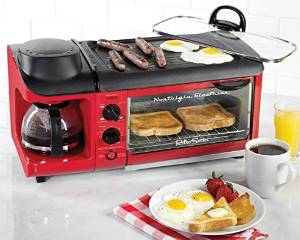
The wife asked innocently, "do you think we can get this to run on solar power?" Leaving aside the relative merits of the product or why I would want to run such a thing on solar power considering the fact that we have two perfectly servicable camp stoves for a moment the question does provide an excuse to think about the problem. Before we can get to an answer we need to understand some things.
Types of Loads
There are two main classes of appliances. The first are those with motors and pumps which use power unevenly with very heavy loads for short periods known as inductive or capacitive loads. The second are those that heat up and draw power more consistently known as resistive loads. In other words, running a refrigerator requires a lot more capacity than running a heater. This appliance is of the latter variety, and the rule of thumb is that for inductive and capacitive loads you should use an inverter that is rated 3 to 5 times the rating on the appliance while for resistive loads you can pretty much use the rating of the appliance to size the inverter you need.
The Breakfast Station
A comment by Joe S on the product page of a 100W Renogy Solar Panel (this is the model I own) was my starting point in this investigation. As we'll find later, the appliance in question is rated at 1500W. I would assume that 1500W is the maximum power and not the nominal power we can expect the thing to consume. Toasters are typically 1000W, but this is really a multi-function appliance with an integrated coffee pot and grill. A coffee maker alone can use 600W, and a grill might be even more. This thing seems fairly power hungry and given the product image used to sell it (making breakfast) its likely you'd want to use all the functions at once, so while I have no real world experience with this thing I'd be concerned right off the bat that we might be closer to that 1500W in normal operation than I initially assumed. This site provides a nice table of common appliances and their typical power requirements. You don't think about how much power you're using till you have to make that power yourself.
We wouldn't be using the appliance all day, just for however long it takes for things to cook. Since it will be running off of a battery bank and not directly off the panel, we'll need to be sure we can use the thing for enough time for the appliance to get its job(s) done on the charge available and subsequently re-charge the batteries in the time allotted to us during daylight remembering that we might want to use the power to do other things.
If we were going to actually size the system appropriately we would probably need more or bigger batteries as well as more solar panels to recharge those batteries afterward than we currently have.
If we were really going to "size" the batteries to this job:
According to the manual, the unit is 1500W and runs on 120V so we would need an inverter. A 1500W inverter can run anywhere from $100 to $300. We should also remember that there is a rule of thumb for about 10% loss in efficiency in the conversion of DC to AC but we'll ignore that for now. 1500W / 12V = 125A so since deep cycle batteries should not be allowed to go below 50% where they begin to become incredibly inefficient and may even be damaged we would need twice that or 2 x 125Ah = 250Ah of capacity. Batteries are typically about 80% efficient suggesting we might need more than just one 260Ah AGM battery at $350 each.
What if we wanted to try to get it to run on our system?
We currently have a single 100W Solar Panel, a battery bank consisting of three 35Ah deep cycle 12V batteries, and a PWM type charge controller. 3 x 35Ah = 105Ah and the batteries aren't new (we should probably account for some loss there). How long will we be able to run this thing on our current battery bank system?
Batterystuff.com explains why you really need a calculator to figure this kind of stuff out, but I'm going to ignore that good advice and just use the following formula.
- Backup Time = Battery AH x 12V x N x Efficiency of Battery / Load in Watts where,
- Battery AH = Ampere Hour Capacity of Battery
- N = Number of 12 V Batteries needed
- Efficiency of Battery = Generally it is 0.8, which is the max. power factor of home standard
(105Ah x 12V x 3 x 0.8) / 1500W = 2 hours
This overly simple formula ignores the fact that we don't want to run our batteries down to 0% since driving them below 50% is inefficient and can damage them and we won't do that so we'll guess and cut the run time in half. Even after we cut it in half as an estimate down to 1 hour, we still haven't taken into consideration the loss of the conversion of DC to AC with the inverter (we said 10% before) so ignoring all that the absolute best case using all three of our current batteries we can run the thing for about 54 minutes? Not sure that's enough time to pre-heat the oven and actually cook anything.
But can we re-charge the batteries in time to use it again the next day?
So, now hopefully we've cooked all of our food and we need to get our batteries charged back up. We live in Zone 5 so we get about 5 hours of solar insolation per day (on average over the year) sufficient for solar power, so our 100W panel standing in full sun for 5 hours can put out about 500W per day. There's some concern about the fact that our charge controller is a PWM type and the losses there (they aren't as efficient as MPPT controllers), but the claim made by Renogy is that the panel can charge up a 50Ah battery from 50% in 3 hours. In my tests it charged a 35Ah battery from about 50% in less time than that.
With three 35Ah batteries in parallel ignoring inefficiencies we might be able to charge them all back up to full on a good sunny day if we didn't use them for any other purposes.
The answer
Yeah, we could probably get it to run off our current batteries for a very short time if we bought a 1500W inverter and we could probably just about charge our batteries back up after using it. However, we wouldn't be able to run anything else or we'd risk not being able to charge them up again enough to use the thing a second time. If we had another panel, and a bigger battery bank we'd probably be fine but in all honesty... why bother?


